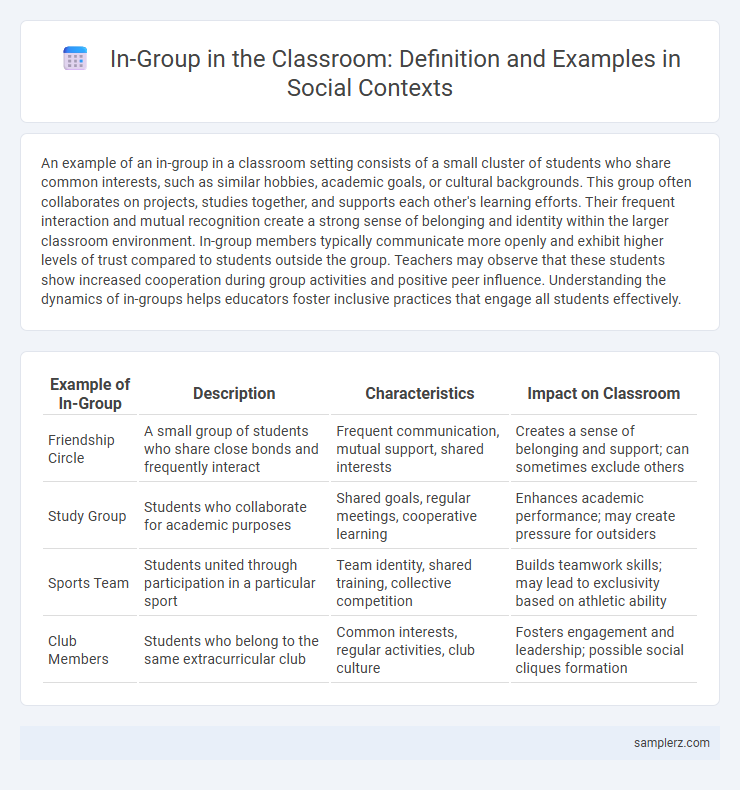An example of an in-group in a classroom setting consists of a small cluster of students who share common interests, such as similar hobbies, academic goals, or cultural backgrounds. This group often collaborates on projects, studies together, and supports each other's learning efforts. Their frequent interaction and mutual recognition create a strong sense of belonging and identity within the larger classroom environment. In-group members typically communicate more openly and exhibit higher levels of trust compared to students outside the group. Teachers may observe that these students show increased cooperation during group activities and positive peer influence. Understanding the dynamics of in-groups helps educators foster inclusive practices that engage all students effectively.
Table of Comparison
| Example of In-Group | Description | Characteristics | Impact on Classroom |
|---|---|---|---|
| Friendship Circle | A small group of students who share close bonds and frequently interact | Frequent communication, mutual support, shared interests | Creates a sense of belonging and support; can sometimes exclude others |
| Study Group | Students who collaborate for academic purposes | Shared goals, regular meetings, cooperative learning | Enhances academic performance; may create pressure for outsiders |
| Sports Team | Students united through participation in a particular sport | Team identity, shared training, collective competition | Builds teamwork skills; may lead to exclusivity based on athletic ability |
| Club Members | Students who belong to the same extracurricular club | Common interests, regular activities, club culture | Fosters engagement and leadership; possible social cliques formation |
Defining In-Groups Within Classroom Settings
In classroom settings, in-groups often form based on shared interests, such as students who participate in the same extracurricular activities or study groups collaborating on projects. These in-groups establish a sense of belonging by reinforcing common goals, values, and communication styles. Understanding in-group dynamics helps educators foster inclusive environments that mitigate social exclusion and promote cooperative learning.
Characteristics of Classroom In-Groups
Classroom in-groups often form based on shared interests, academic performance, or social status, creating a sense of belonging and identity among members. These groups tend to exhibit strong cohesion, frequent communication, and mutual support, influencing students' participation and motivation. The presence of in-groups can impact classroom dynamics by fostering collaboration within groups while sometimes leading to exclusion of others.
Friendship Cliques as In-Groups
Friendship cliques in classrooms create distinct in-groups characterized by shared interests, mutual trust, and exclusive social bonds. These groups influence student behavior, peer acceptance, and social status within the academic environment. Understanding friendship cliques helps educators foster inclusive interactions and address social dynamics effectively.
Academic Performance-Based In-Groups
Academic performance-based in-groups in a classroom often consist of students who consistently achieve high grades and actively participate in discussions, forming a respected peer cluster. These groups influence study habits and motivation, creating a collaborative environment that promotes academic excellence. Membership in such in-groups can enhance access to shared resources, peer tutoring, and informal learning networks.
Cultural or Ethnic In-Groups Among Students
Cultural or ethnic in-groups in classrooms often form around shared language, traditions, and cultural practices that strengthen students' sense of identity and belonging. These groups can influence social dynamics by providing emotional support, reinforcing cultural pride, and sometimes creating barriers to cross-cultural interaction. Understanding the presence of such in-groups helps educators foster inclusive environments that respect diversity and encourage intercultural dialogue.
Extracurricular Activity In-Groups
Extracurricular activity in-groups in classrooms often form around shared interests such as sports teams, drama clubs, or academic societies, creating a strong sense of belonging among members. These in-groups foster social cohesion and enhance peer support, leading to increased student engagement and improved teamwork skills. Participation in such groups positively impacts students' social development and academic motivation.
In-Groups Formed by Shared Interests
In a classroom setting, in-groups often form around shared interests such as sports, music, or academic subjects like science and literature. These groups create a sense of belonging and foster collaboration among students who engage in similar extracurricular activities or study topics. This social dynamic enhances peer support and promotes a positive learning environment.
Gender-Based In-Groups in Classrooms
Gender-based in-groups in classrooms often form when students align themselves with peers of the same gender, creating social circles that influence interaction patterns and participation. These groups impact classroom dynamics by shaping communication styles, collaborative behaviors, and sometimes contributing to gender stereotypes. Teachers can observe these in-groups to promote inclusive activities that encourage cross-gender cooperation and reduce gender-based social divisions.
Effects of In-Groups on Classroom Dynamics
In-groups within classrooms, such as study groups or friend circles, significantly influence student participation and collaboration, often creating a sense of belonging that boosts confidence and academic performance. These groups can also lead to exclusion or social hierarchies, impacting peer relationships and classroom cohesion. Understanding in-group dynamics helps educators foster inclusive environments that promote equal engagement and reduce social barriers.
Strategies for Promoting Inclusivity Among In-Groups
Encouraging group projects that mix diverse students fosters collaboration and breaks down social barriers within classroom in-groups. Implementing peer mentoring programs helps integrate marginalized students into established social circles, promoting a sense of belonging. Facilitators can also organize inclusive activities that highlight each member's strengths, reinforcing positive group identity and reducing exclusivity.

example of in-group in classroom Infographic
 samplerz.com
samplerz.com